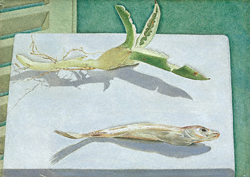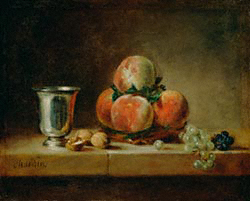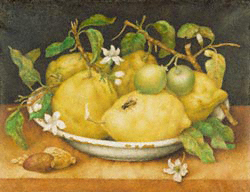 |

 |
 |
Still Life with Aloe, Lucian Freud, 1949–50. Private Collection.
© Lucian Freud
|
 |
Three still lifes—one on loan from a private collection and two from the J. Paul Getty Museum's permanent collection—are on display in the Getty Center's South Pavilion, Gallery S203, through April 5, 2009.
Lucian Freud's Still Life with Aloe (1949–50) is exhibited alongside the Getty's Still Life with Peaches, a Silver Goblet, Grapes, and Walnuts (about 1760) by Jean-Siméon Chardin and Still Life with Bowl of Citrons (late 1640s) by Giovanna Garzoni.
|
|
The installation represents the third installment of the Museum's Interjections series, in which a loaned contemporary work of art is added to the Museum's galleries, enlivening the permanent collection. Freud's Still Life is a generous 12-week loan from a private collection.
Freud, who has been described by art critic Robert Hughes as "the greatest living realist painter," is well versed in the Western tradition of painting and has long admired the talent and skill of the Old Masters. He looks closely at that tradition—borrowing from it to create works that are grounded in the contemporary while paying homage to the grandeur of Velazquez, the unusual juxtapositions of Surrealism, and the frivolity of Watteau. In this particular work from his early career, he places an aloe plant and a fish carcass on a horizontal plane or table, which is spatially incongruent with the vertical shutters that are depicted behind and adjacent to the table rather than perpendicular to it. There are formal similarities between the two, yet there is a disquieting juxtaposition of these otherwise unrelated objects.
|
|
Freud's Still Life is displayed next to Giovanna Garzoni's Still Life with Bowl of Citrons (late 1640s), which depicts robust citrons with their leafy branches still attached filling a worn ceramic bowl to overflowing. Garzoni's acute observation of nature and refined handling of paint are evident in the carefully rendered citron skin and in the wasp's delicate wings. With its central bowl of fruit, this painting is characteristic of Garzoni's style; a single flower or insect placed in front of the picture plane adds interest to the composition. Garzoni deliberately manipulated textures and shapes, contrasting the citrons' rough skin and rounded weightiness with the sharp-edged branches, the glistening, green leaves, and the delicate, star-like blossoms. Garzoni's skillful depictions of natural objects, usually fruits and insects arranged in pleasing ensembles, were among the paintings most coveted by wealthy patrons.
The Freud still life is also juxtaposed with Jean-Siméon Chardin's Still Life with Peaches, a Silver Goblet, Grapes, and Walnuts. In this small canvas, Chardin portrayed modest subjects—three walnuts, four peaches, two bunches of grapes, and a pewter mug—but gave the objects monumentality by arranging them in pure geometric groupings and concentrating on their basic forms. He suggested the objects' various textures and substances through the play of light across surfaces and successive applications of paint. In this way, Chardin conveyed the fuzzy skin of the peaches, the hard, brittle shell of the walnuts, the translucence of the grapes, and the heavy, cold exterior of the pewter mug.
|
|
Grandson of the famous Austrian psychiatrist Sigmund Freud, Lucian Freud was born in Berlin, Germany, in 1922 and moved to England in 1933. Between 1938 and 1943 he trained at the Central School of Arts and Crafts, and the East Anglian School of Painting and Drawing; he graduated from Goldsmiths College in 1943. Freud is one of the best known British artists working in a traditional representational style.
Note: This installation was originally planned to end on April 5, 2009, however, the ending date has been changed to March 29. We apologize for any inconvenience this may cause.
|


